The easiest method to get offspring from a beautiful orchid is reproduction by processes that appear on a healthy mother plant and are called babies. When such a layering grows on a plant on the trunk, this is always a joyful event, but the fact of its appearance is not enough for growing a new flower. Many breeders face a common problem: baby orchids without roots. What to do in this case?
Content
Why the sprout of an orchid does not give roots
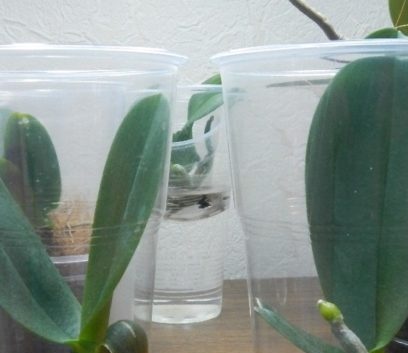 Orchid is an elegant and elegant plant that can cause a sense of pride in any grower. However, this charming beauty is not easy to care for: orchids are moody and demanding. However, experienced owners know that it’s possible to tackle breeding phalaenopsis at home subject to a number of recommendations.
Orchid is an elegant and elegant plant that can cause a sense of pride in any grower. However, this charming beauty is not easy to care for: orchids are moody and demanding. However, experienced owners know that it’s possible to tackle breeding phalaenopsis at home subject to a number of recommendations.
And rooting a baby orchid without roots is difficult. The reason is usually the lack of proper care for the choosy mother plant. If you had to face a similar situation, you need to pay attention to the conditions in which "mommy" is contained:
- Lighting mode. Orchid for healthy development, especially during the appearance of the shoots, requires a lot of sunlight. And not scorching rays, which can lead to burns of a delicate plant, but diffused soft lighting. The recommended daylight hours for phalaenopsis is from 12 hours. If there is no way to ensure this condition in natural mode, you need to buy phytolamps.
- Wrong watering. Monitor the soil moisture in the pot and pay attention to the color of the roots of the plant. If they begin to turn pale, it's time to water. If the flower lives in an opaque container, the pot walls may become an indicator: when they are dry, moistening the soil is necessary. If the soil lacks moisture, then the tiny roots appearing on the shoots instantly dry out, as the stronger mother plant absorbs all the water. Rooting does not occur.
- Top dressing. The basic rule is to choose fertilizer to feed the capricious beauty and add it regularly according to the recommendations. Due to the specific composition of the soil for orchids, planted crops should be fed only with liquid nutrient solutions, which can evenly distribute between bark fragments and prevent overdose of microelements that is harmful to the plant.
Favorable factors for the appearance of children
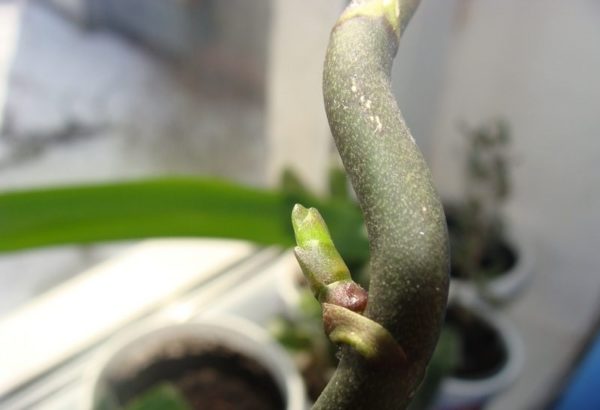 In order for the orchid to start sprouting, a number of conditions must be met:
In order for the orchid to start sprouting, a number of conditions must be met:
- the mother plant must reach "adulthood", the signs of which are the presence of large leaves (at least four) and a fairly stable root system;
- the most favorable period for reproduction is spring and the first month of summer;
- orchid entered the final phase of flowering;
- optimal humidity level - 50-60%;
- correct light mode - from 12 hours of intense soft light.
If, with the combined presence of all these factors, the plant does not begin to produce babies, this process can be stimulated. For example, to ensure that the air temperature fluctuates from 17 ° C at night, to 30 ° C during the day. A combination of moderate or even scarce soil irrigation with sufficiently high humidity helps. You can make a substrate in the form of a pallet with wet moss and install a pot on it and put the baby there.
Orchid kids: where do they appear and whether to separate
For the mother plant, all conditions are created and, finally, processes have appeared. They are an exact small copy of the mother’s orchid and, having reached adulthood, will have the same size, shape and shade of flowers. Already on the parental trunk, the baby often looks like a fully formed clone of mature phalaenopsis - she has leaves, a stalk, and flowering can even begin.
The processes can be formed in various areas:
- at the root;
- on a peduncle;
- on the stem.
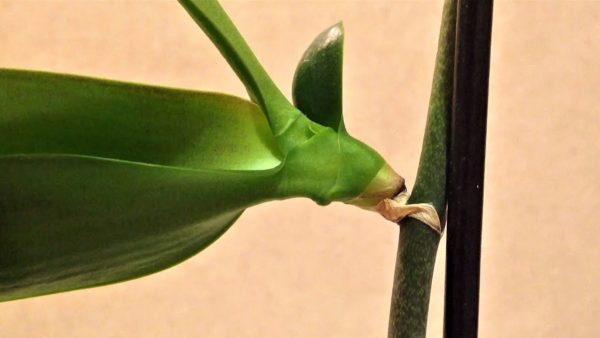 From the beginning of the appearance of the first leaves to the separation of the baby usually takes from 4 to 6 months. The most important condition is that the baby orchid must grow roots. It is better if it is already a few roots a few centimeters long. Transplanting a young plant during the flowering period of the mother is not recommended. Depending on where the young plant grew, recommendations for its separation differ.
From the beginning of the appearance of the first leaves to the separation of the baby usually takes from 4 to 6 months. The most important condition is that the baby orchid must grow roots. It is better if it is already a few roots a few centimeters long. Transplanting a young plant during the flowering period of the mother is not recommended. Depending on where the young plant grew, recommendations for its separation differ.
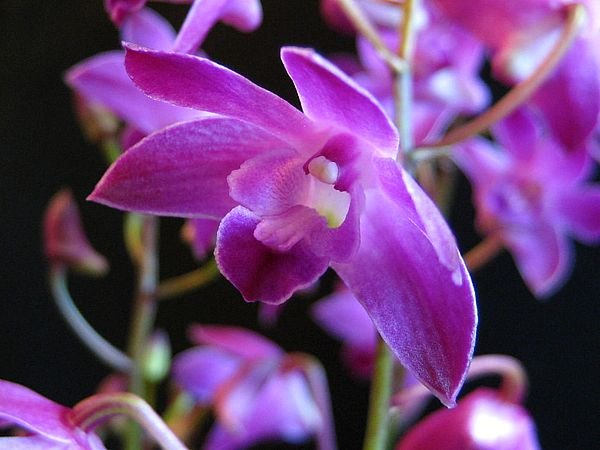 You may be interested in:
You may be interested in:Department of the root baby
Before proceeding with the propagation of orchids by separating the process that has grown at the root, it is necessary to make sure that the root system of the young plant is sufficiently developed and it is ready to begin to develop independently:
- Raise the substrate and evaluate the size of the roots - they should be at least 5 cm long.
- Prepare tools and materials. You will need: sphagnum, bark, secateurs, cinnamon, activated carbon, a small pot - the container made of transparent plastic is best suited.
- Gently cut off the root system of the baby from the parent using a secateurs.
- The place of cut is treated with cinnamon or activated carbon.
- Transplant the new plant into a separate pot with pre-prepared pieces of bark.
If the baby appeared on the peduncle
This is the most common version of the formation of the process. Moreover, if the orchid is provided with additional intensive lighting and sufficient humidity and temperature for propagation, several children may appear at once on a single flower stalk. The criterion for the readiness of a young lay for transplantation is the same as for root children: the presence of their own root system with a length of 5 centimeters or more.The list of tools is the same in this case: bark, secateurs, transparent pot, cinnamon, activated carbon, sphagnum.
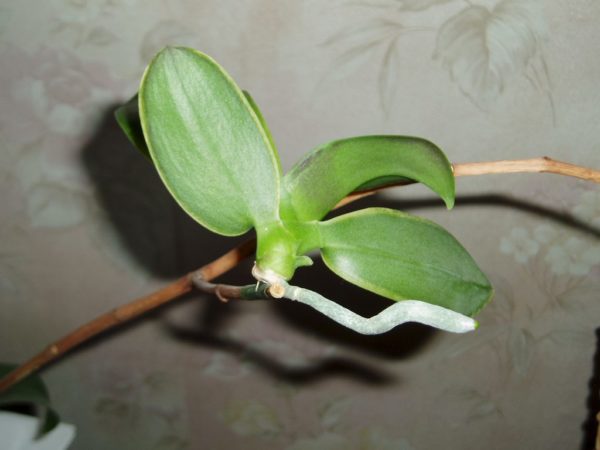 So, everything is ready for the separation of the baby. Where to begin?
So, everything is ready for the separation of the baby. Where to begin?
- Leaving a gap of about 1.5 centimeters, cut off the pruning from the parent peduncle with secateurs.
- Process dried slices with charcoal or cinnamon.
- Position the young phalaenopsis in a pot so that the roots are slightly higher than the edge of the container.
- Holding the plant by the stem, gradually and evenly pour soil from the shallow bark into the pot. Tamping is not necessary - it is easy enough to knock on the walls of the tank so that the substrate is distributed inside.
- The first watering is allowed a few days after separation.
It is believed that the beautiful orchid gives birth only on the eve of its death. This is conditionally true for the case when the baby is formed on the mother's trunk.Such orchids on the trunk do not form their own roots, but feed and develop from the resources of the parent plant. If the process of the orchid is from the stem, it does not need to be separated from the uterine stem. It is necessary to wait for the natural dying off of an adult orchid, and then look after young phalaenopsis.
Ways to grow roots in a baby orchid
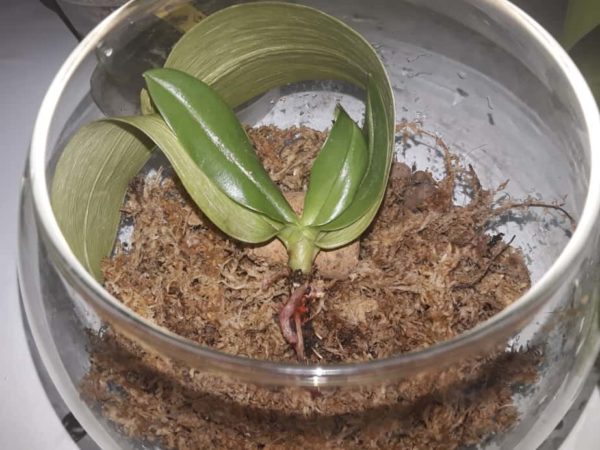 Ideally, the baby should begin to form roots just four months after the appearance. However, what if the leaves and stems are already formed, and there are no roots yet, is it possible to grow roots or just transplant an orchid baby without roots?
Ideally, the baby should begin to form roots just four months after the appearance. However, what if the leaves and stems are already formed, and there are no roots yet, is it possible to grow roots or just transplant an orchid baby without roots?
A variant with the separation of the appendix, which did not give its roots, is possible. It is important to understand that this is risky enough for a young plant. Before deciding, it is better to try to grow roots while the little clone is still on the mother’s peduncle.
How to grow roots on a peduncle:
- Orchid lovers often resort to the method of root growth using sphagnum. You need to be patient - to grow roots, it will take several months.
- Put the moss in water and allow it to fully absorb moisture. Sphagnum should swell and gain weight.
- Roll a sufficiently dense ball of wet moss so that it does not fall apart, attach it to the base of the peduncle and fix with a thread. Do not tie the nutrient base too tight so as not to cut the stem.
- You can wrap the place of attachment with cling film. The mother plant is best fixed in a stable position with props and clamps. This will save mom orchid from overturning.
- The main condition for stimulating growth is the daily moistening of the moss by spraying and the creation of a favorable temperature regime: the room should be moist and warm.
- Do not forget about regular airing.
In addition to natural methods, there are artificial ones that are also popular in the propagation of orchids.
How to grow roots in a greenhouse:
- Prepare a greenhouse: for example, a large plastic bottle with drainage holes, lay a substrate of small pieces of bark on the bottom.
- Separate the cuttings from the maternal peduncle and place the young plant in the greenhouse.
- As a nutrient base, moist moss is suitable, which should be laid on top of the ground in the form of a substrate for the baby.
- Spray the shoot daily, while ensuring that moisture does not stagnate in the ground - it should dry completely in a few hours. It is recommended to spray in the daytime.
You can save a newborn baby orchid by planting it in polystyrene foam and creating ideal conditions for the appearance of its roots.
How to grow the root system in polystyrene foam:
- In a piece of polystyrene foam, make a hole of such a diameter so that the base of the process freely fits into it.
- Fix the structure in a container with water so that the lower part of the baby was at a small distance from the water, but was not immersed in it.
- Humidity can be increased by creating a greenhouse effect - covering the polystyrene with a plastic bottle with a cut-off top or a Plexiglass dome.
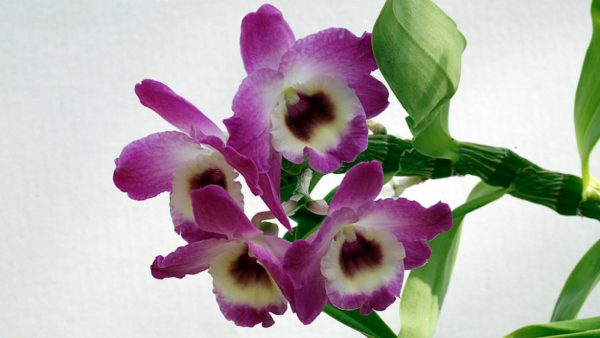 You may be interested in:
You may be interested in:Growing orchids yourself is troublesome and long. This is not a quick process that requires patience and love for plants. At the same time, the appearance of children in a capricious beauty is a real miracle. It is worth the effort and time: amazing flowers delight the eye and fill the heart with the joy of those who plant and propagate them.

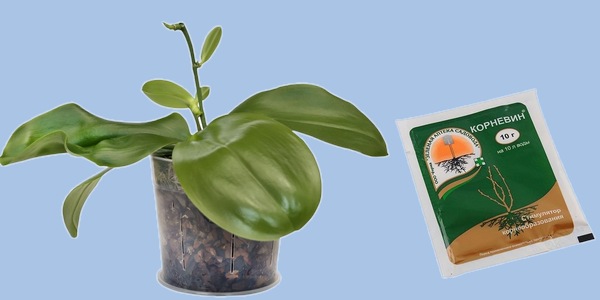
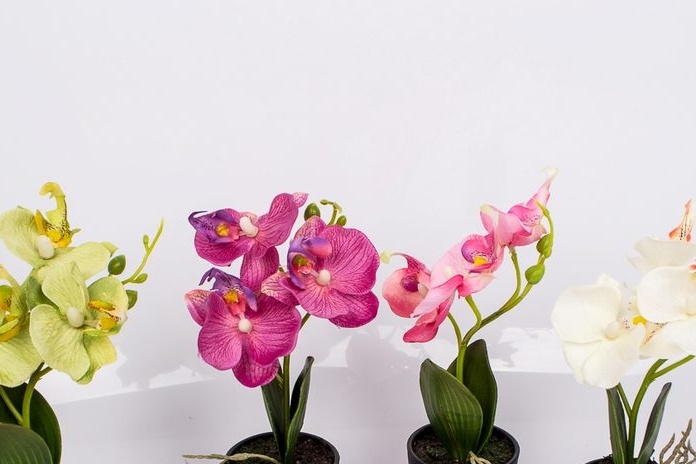
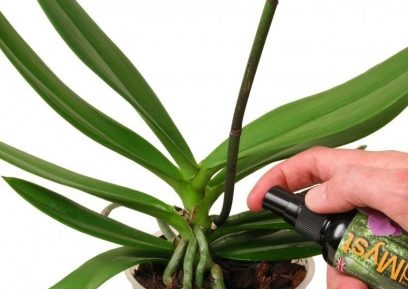
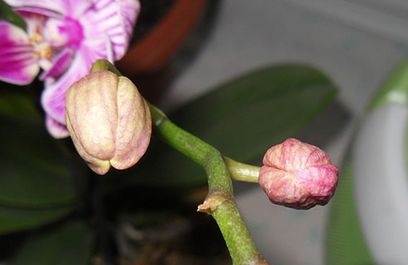 Reasons why orchids fall flowers and what to do
Reasons why orchids fall flowers and what to do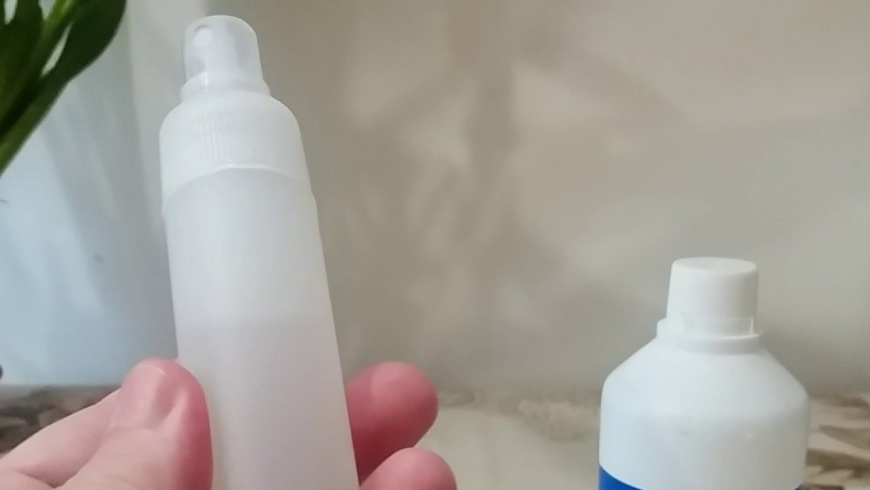 How to use hydrogen peroxide for orchids and why
How to use hydrogen peroxide for orchids and why Midges are wound up in the orchid: effective ways to get rid
Midges are wound up in the orchid: effective ways to get rid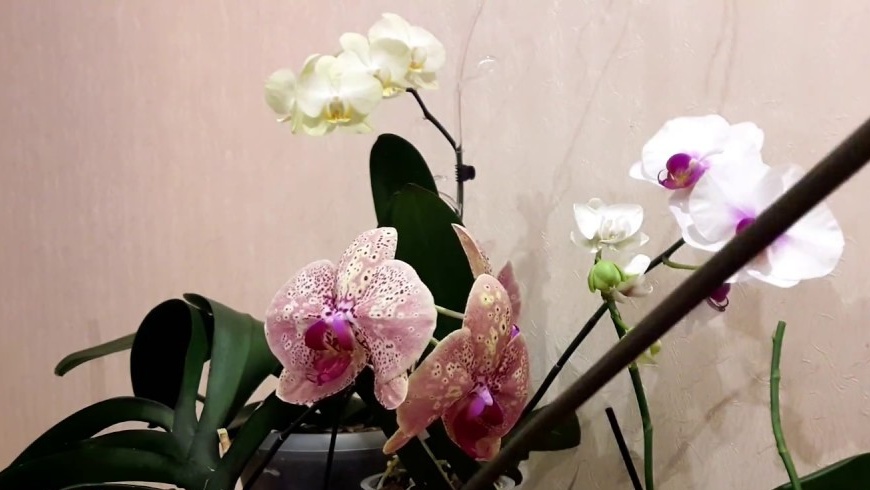 Is it possible to transplant an orchid during flowering
Is it possible to transplant an orchid during flowering